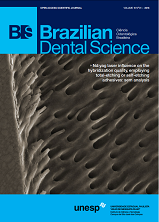Effect of the photoinitiator system on the properties of a dental material based on a hybrid polymer
DOI:
https://doi.org/10.14295/bds.2016.v19i1.1233Abstract
Objective: In this study, the effects of two different cure protocols upon the properties of composites using a hybrid-polymer as dental resin were evaluated. Material and Methods: Two distinct dental composites were prepared, one containing a mixture of TEGDMA/bis-GMA (50:50) and, another containing a mixture of TEGDMA/p-MEMO (50:50), [p-MEMO: oligomeric inorganic precursor]. Both composites were polymerized with lucirin and canphorquinone as photoinitiators. The composites were made with a 70 % wt of inorganic filler. Flexural strength was evaluated with a universal test machine and the degree of conversion was measured by infrared spectroscopy. A helium pycnometer was used to obtain polymer shrinkage data. Sorption tests were performed and SEM microscopy was used to show deleterious effects upon the resins’ surfaces. Results: The sample base on TEGDMA/p-MEMO polymerized with lucirin (L-T/p) showed the best values of the monitored properties. Conclusion: Lucirin is the most suitable photoinitiator for dental composites containing hybrid polymers.
Keywords
Dental resins; Flexural strength; Hybrid polymer; Photoinitiator system; Polymerization shrinkage.
Downloads
Downloads
Published
How to Cite
Issue
Section
License
Brazilian Dental Science uses the Creative Commons (CC-BY 4.0) license, thus preserving the integrity of articles in an open access environment. The journal allows the author to retain publishing rights without restrictions.
=================




























